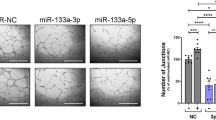Abstract
The sprouting of new blood vessels by angiogenesis is critical in vascular development and homeostasis. Aberrant angiogenesis leads to enormous pathological conditions such as ischemia and cancer. MicroRNAs (also known as miRNAs or miRs) play key roles in regulation of a range of cellular processes by posttranscriptional suppression of their target genes. Recently, new studies have indicated that miRNAs are involved in certain angiogenic settings and signaling pathways use these non-coding RNAs to promote or suppress angiogenic processes. Herein, VEGFR2 and FGFR1 were identified as miR-129-1 and miR-133 targets using bioinformatic algorithms, respectively. Afterwards, using luciferase reporter assay and gene expression analysis at both mRNA and protein levels, VEGFR2 and FGFR1 were validated as miR-129-1 and miR-133 targets. In addition, we showed that miR-129-1 and miR-133 suppress angiogenesis properties such as proliferation rate, cell viability, and migration activity of human umbilical vein endothelial cells (HUVEC) in vitro. We conclude that these miRNAs can suppress key factors of angiogenesis by directly targeting them. These results have important therapeutic implications for a variety of diseases involving deregulation of angiogenesis, including cancer.







Similar content being viewed by others
References
Ichihara E, Kiura K, Tanimoto M. Targeting angiogenesis in cancer therapy. Acta Med Okayama. 2011;65(6):353–62.
Rivera LB, Bergers G. CANCER. Tumor angiogenesis, from foe to friend. Science. 2015;349(6249):694–5.
Sakurai T, Kudo M. Signaling pathways governing tumor angiogenesis. Oncology. 2011;81(1):24–9.
Tonini T, Rossi F, Claudio PP. Molecular basis of angiogenesis and cancer. Oncogene. 2003;22(42):6549–56.
Olsson AK, Dimberg A, Kreuger J, Claesson-Welsh L. VEGF receptor signalling—in control of vascular function. Nat Rev Mol Cell Biol. 2006;7(5):359–71.
Presta M, Dell'Era P, Mitola S, Moroni E, Ronca R, Rusnati M. Fibroblast growth factor/fibroblast growth factor receptor system in angiogenesis. Cytokine Growth Factor Rev. 2005;16(2):159–78.
Rad SM, Langroudi L, Kouhkan F, Yazdani L, Koupaee AN, Asgharpour S, et al. Transcription factor decoy: a pre-transcriptional approach for gene downregulation purpose in cancer. Tumour Biol. 2015;36(7):4871–81.
Dyrskjot L, Ostenfeld MS, Bramsen JB, Silahtaroglu AN, Lamy P, Ramanathan R, et al. Genomic profiling of microRNAs in bladder cancer: miR-129 is associated with poor outcome and promotes cell death in vitro. Cancer Res. 2009;69(11):4851–60.
Tsai KW, Wu CW, Hu LY, Li SC, Liao YL, Lai CH, et al. Epigenetic regulation of miR-34b and miR-129 expression in gastric cancer. Int J Cancer. 2011;129(11):2600–10.
Chen JF, Mandel EM, Thomson JM, Wu Q, Callis TE, Hammond SM, et al. The role of microRNA-1 and microRNA-133 in skeletal muscle proliferation and differentiation. Nat Genet. 2006;38(2):228–33.
Heusschen R, van Gink M, Griffioen AW, Thijssen VL. MicroRNAs in the tumor endothelium: novel controls on the angioregulatory switchboard. Biochim Biophys Acta. 2010;1805(1):87–96.
Liu Y, Wang W, Wang J, Wang Y, Yuan Z, Tang S, et al. Blood compatibility evaluation of poly(D,L-lactide-co-beta-malic acid) modified with the GRGDS sequence. Colloids Surf B Biointerfaces. 2010;75(1):370–6.
Li YX, Liu DQ, Zheng C, Zheng SQ, Liu M, Li X, et al. miR-200a modulate HUVECs viability and migration. IUBMB Life. 2011;63(7):553–9.
Wurdinger T, Tannous BA, Saydam O, Skog J, Grau S, Soutschek J, et al. miR-296 regulates growth factor receptor overexpression in angiogenic endothelial cells. Cancer Cell. 2008;14(5):382–93.
Suarez Y, Sessa WC. MicroRNAs as novel regulators of angiogenesis. Circ Res. 2009;10(4):442–54.
Fish JE, Srivastava D. MicroRNAs: opening a new vein in angiogenesis research. Sci Signal. 2009;2(52):pe1.
Wu J, Qian J, Li C, Kwok L, Cheng F, Liu P, et al. miR-129 regulates cell proliferation by downregulating Cdk6 expression. Cell Cycle. 2010;9(9):1809–18.
Karaayvaz M, Zhai H, Ju J. miR-129 promotes apoptosis and enhances chemosensitivity to 5-fluorouracil in colorectal cancer. Cell Death Dis. 2013;4:e659.
Bushati N, Cohen SM. microRNA functions. Annu Rev Cell Dev Biol. 2007;23:175–205.
Chamorro-Jorganes A, Araldi E, Penalva LO, Sandhu D, Fernández-Hernando C, Suárez Y. MicroRNA-16 and microRNA-424 regulate cell-autonomous angiogenic functions in endothelial cells via targeting vascular endothelial growth factor receptor-2 and fibroblast growth factor receptor-1. Arterioscler Thromb Vasc Biol. 2011;31(11):2595–606.
Acknowledgments
This project has been funded by Tarbiat Modares University and Stem Cell Technology Research Center, Tehran, Iran. The authors also thank Arash Veshkini for assistance in preparing the Figures.
Author information
Authors and Affiliations
Corresponding author
Ethics declarations
Conflicts of interest
None
Additional information
Abbas Hajifathali and Fatemeh Kouhkan contributed equally to this work.
Rights and permissions
About this article
Cite this article
Soufi-zomorrod, M., Hajifathali, A., Kouhkan, F. et al. MicroRNAs modulating angiogenesis: miR-129-1 and miR-133 act as angio-miR in HUVECs. Tumor Biol. 37, 9527–9534 (2016). https://doi.org/10.1007/s13277-016-4845-0
Received:
Accepted:
Published:
Issue Date:
DOI: https://doi.org/10.1007/s13277-016-4845-0




